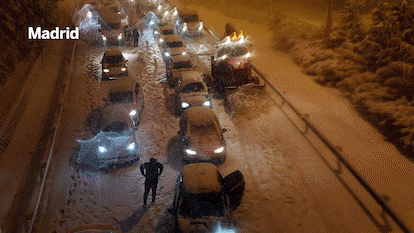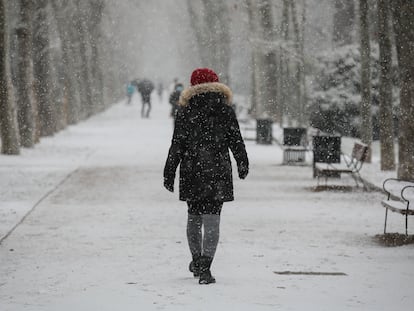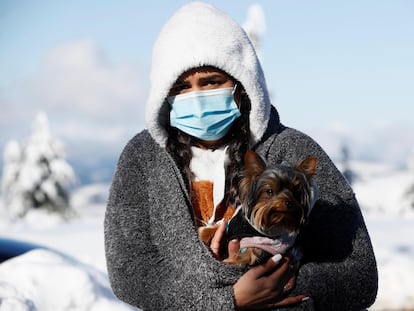Storm Filomena sees 10 Spanish provinces on alert, Madrid grind to a halt and Barajas Airport closed
The worst snow seen this century has caused chaos, leaving three dead and hundreds of drivers trapped in their vehicles. Madrid, Albacete, Cuenca, Toledo, Guadalajara, Valencia, Castellón, Tarragona, Teruel and Zaragoza are expected to see 20 centimeters of snowfall

Storm Filomena left hundreds of Spaniards trapped on the country’s freeways last night, with Madrid the epicenter of the chaos caused by the weather. The capital, where snow chains were needed for vehicles, saw public buses grind to a halt and garbage collection suspended. A historic amount of snow, the biggest fall seen in the last 40 or 50 years, left some surreal images, such as a sled being pulled along by dogs in the city streets, skiers in the central Puerta del Sol and snowball fights in iconic Callao square.
Se nos va de las manos. #frio #BorrascaFilomena_RM #Filomena #NieveenMadrid #nievemadrid #Madrid pic.twitter.com/NYz7UTjO14
— EL🐑HOMBRE #MONTAÑA (@HombreMontana) January 8, 2021
“This has got out of hand,” reads this tweet, in which a man is seen on a sled pulled by dogs in Madrid.
But there were also worrying sights too, with an undetermined number of people left stuck in their cars on freeways, including the M-30 and M-40 ring roads. The army, via the Military Emergency Unit (UME), intervened last night to try to rescue people who were stuck on the A-5 freeways (Móstoles and Alcorcón), the A-4 (Aranjuez and Ciempozuelos) and the A-3 (Arganda and Rivas Vaciamadrid).
A number of truck drivers were also left stuck by the weather in provinces throughout Spain. In Guadalajara alone there were 1,300 trucks stopped in winter parking lots.
Meanwhile, Madrid-Barajas Adolfo Suárez Airport was forced to close at 10pm, and is not due to be reopened on Saturday. There were also cancelations and delays to train services and the suspension of sea crossings.
Spanish Prime Minister Pedro Sánchez called on citizens to avoid making journeys and to follow instructions from the emergency services. He also paid tribute to the latter for their efforts to rescue people who had become trapped in the snow.
Evitemos los desplazamientos y sigamos las indicaciones de los servicios de emergencia. Extrememos la precaución ante la borrasca #Filomena.
— Pedro Sánchez (@sanchezcastejon) January 9, 2021
Una vez más, enorme el trabajo de la @UMEgob y los profesionales que están intentando rescatar a las personas atrapadas en la nieve. https://t.co/3nvdmEGoq2
On Saturday morning Madrid City Hall issued a request for citizens to stay in their homes, due to incidents such as falling trees and branches as well as masonry from buildings under the weight of the snow. The regional government, meanwhile, announced that schools and universities would not open on Monday and Tuesday.
The Public Works minister in the region of Castilla-La Mancha, Nacho Hernando, also made a “heartfelt” plea for citizens to stay at home, saying that these weather conditions have not been seen in the territory since 1904. The region has also closed schools and universities on Monday and Tuesday.
So far, three people in Spain are reported to have died due to the weather conditions. The first was a homeless person aged 30 who was found dead in a doorway in Calatayud (Zaragoza), while a couple residing in Mijas (Málaga) died in the early hours of Saturday after becoming trapped in their vehicle, which was washed away by the current from the River Fuengirola.
The Spanish authorities have recommended that anyone who is stuck in their vehicle should leave the engine running and the heating on. They also advise not removing snow from the roof of the vehicle and ensuring that the tailpipe is unobstructed.
Los madrileños estuvieron esquiando hoy en la Puerta del Sol. El apocalipsis nos sigue guiñando un ojo. pic.twitter.com/ZJVRP4fKOm
— Fernando Krakowiak (@fkrakowiak) January 9, 2021
A man is seen skiing through Madrid’s Puerta del Sol square.
The worst of Filomena, however, is still to come. Another day of highly adverse weather conditions is expected from the storm, with a mass of cold air over the peninsula bringing with it snow, rain, wind, choppy seas and low temperatures.
The weather front is due to continue moving and on Saturday will arrive at the Mediterranean, according to Rubén del Campo, the spokesperson for Spain’s AEMET state weather agency. The humid winds from the Mediterranean will give it even more fuel for the precipitation to intensify in the east of the peninsular mostly in the form of snow.
If the alert map on Friday had never been seen before – it was the first time a red alert for snow was registered in the central region since 2007, when the current system was introduced – for this weekend the situation is beyond description. The red alerts will go from six to 10 provinces, in the regions of Madrid, Castilla-La Mancha, Valencia, Catalonia and Aragón.
These provinces are: Madrid, Albacete, Cuenca, Toledo, Guadalajara, Valencia, Castellón, Tarragona, Teruel and Zaragoza. Twenty centimeters of snow are expected in all these areas at all altitudes.
❄️ GUERRA DE NIEVE ENTRE DESCONOCIDOS EN MADRID
— Nicolás de León (@salocinuy) January 9, 2021
ESTO ES FABULOSO🤣🤣 pic.twitter.com/HjXbQB4TdR
A snowball fight among members of the public in Callao, Madrid.
Another 19 provinces are on orange alert, the second on a scale of three, for 30 centimeters of snow: Cáceres, Ávila, Huesca, Valladolid, Burgos, Segovia, Salamanca, Palencia, Soria, Barcelona, Girona, Lleida, La Rioja, Navarra, Zaragoza, Cantabria Gipuzkoa, Álava and Bizkaia. Another seven provinces, Badajoz, Ciudad Real, Murcia, Alicante, Asturias, León and Zamora, have a yellow warning, the lowest level, for two to 15 centimeters of snowfall. In total, 36 of Spain’s provinces have some kind of alert for snow. The snowfall, according to Del Campo, is the worst seen in the century so far and in the central region, the worst in 40 years.
Heavy rainfall and storms are also predicted in the southeast of the Balearic Islands, the south of Andalusia and areas of the Canary Islands. In these areas there are yellow alerts due to the possibility of 20 liters of rainfall per square meter. At the same time, the cold weather will continue and the mercury is unlikely to rise above 0ºC the whole day, with strong winds also forecast on the Galician, Andalusian Mediterranean and north Mediterranean coasts.
On Sunday, AEMET forecasts strong winds in Catalonia and that Andalusia and the Balearic Islands will continue to see snow at low altitudes. Cantabria, the Basque Country, Navarre, La Rioja, Aragón and Catalonia will also see more snowfall above an altitude of 200 to 300 meters. It could also continue to snow, albeit not so heavily, in other areas of the north and the central region. After the heavy snowfall, even colder weather will arrive, temperatures not seen in Spain since the 1940s or 1950s. AEMET expects that from Monday the conditions could be met that would constitute a cold snap. It would be the first seen in the last two winters, and will also be “significant” should the forecasts be met, Del Campo explained.
English version by Simon Hunter.










































